
MV Virginian, formerly named the MV Strong Virginian (T-AKR-9205), is a combination container, heavy lift, and roll-on/roll-off ship. Owned and operated by Sealift Incorporated of Oyster Bay, New York, the ship is one of seventeen container—roll-on/roll-off ships in use by the Military Sealift Command, and one of 28 ships assigned to that organization's Sealift Program Office. The ship was previously known as the MV Saint Magnus and the MV Jolly Indaco.
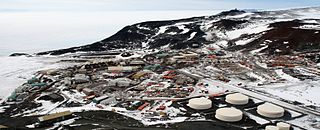
McMurdo Station is a United States Antarctic research station on the south tip of Ross Island, which is in the New Zealand-claimed Ross Dependency on the shore of McMurdo Sound in Antarctica. It is operated by the United States through the United States Antarctic Program (USAP), a branch of the National Science Foundation. The station is the largest community in Antarctica, capable of supporting up to 1,200 residents, and serves as one of three year-round United States Antarctic science facilities. All personnel and cargo going to or coming from Amundsen–Scott South Pole Station first pass through McMurdo. By road, McMurdo is 3 kilometres (1.9 mi) from New Zealand's smaller Scott Base.

Military Sealift Command (MSC) is an organization that controls the replenishment and military transport ships of the United States Navy. Military Sealift Command has the responsibility for providing sealift and ocean transportation for all US military services as well as for other government agencies. It first came into existence on 9 July 1949 when the Military Sea Transportation Service (MSTS) became solely responsible for the Department of Defense's ocean transport needs. The MSTS was renamed the Military Sealift Command in 1970.

McMurdo Sound, a sound in Antarctica, is the southernmost navigable body of water in the world, located approximately 1,300 kilometres (810 mi) from the South Pole.

USCGC Polar Star (WAGB-10) is a United States Coast Guard heavy icebreaker. Commissioned in 1976, the ship was built by Lockheed Shipbuilding and Construction Company of Seattle, Washington along with sister ship, USCGC Polar Sea.
Operation Deep Freeze is codename for a series of United States missions to Antarctica, beginning with "Operation Deep Freeze I" in 1955–56, followed by "Operation Deep Freeze II", "Operation Deep Freeze III", and so on.. Given the continuing and constant US presence in Antarctica since that date, "Operation Deep Freeze" has come to be used as a general term for US operations in that continent, and in particular for the regular missions to resupply US Antarctic bases, coordinated by the United States military. Task Force 199 was involved.
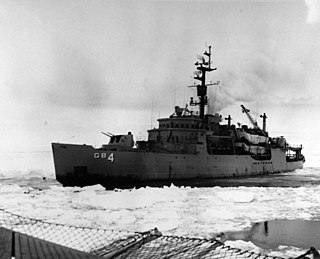
USS Glacier (AGB-4) was a U.S. Navy, then U.S. Coast Guard icebreaker which served in the first through fifteenth Operation Deep Freeze expeditions. Glacier was the first icebreaker to make her way through the frozen Bellingshausen Sea, and most of the topography in the area is named for her crew members. When built, Glacier had the largest capacity single armature DC motors ever installed on a ship. Glacier was capable of breaking ice up to 20 feet (6.1 m) thick, and of continuous breaking of 4-foot (1.2 m) thick ice at 3 knots.
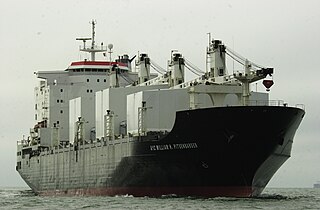
MV A1C William H. Pitsenbarger was a civilian-crewed container ship operated by Red River Shipping Corp. of Rockville, Maryland, under charter to Military Sealift Command from 2001 to 2008. She was named in honor of William H. Pitsenbarger, a US Air Force Medal of Honor recipient.
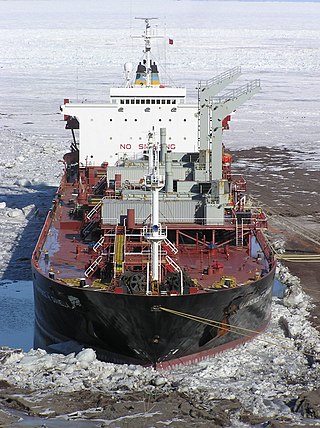
USNS Lawrence H. Gianella (T-AOT-1125) is a United States Military Sealift Command product tanker which typically carries diesel, gasoline, and JP5.

Marble Point is a rocky promontory on the coast of Victoria Land, Antarctica. The United States operates a station at the point. The outpost is used as a helicopter refueling station supporting scientific research in the nearby continental interior, such as the McMurdo Dry Valleys. Dependent upon the weather conditions at the time, helicopters are able to fly in and out of the station 24 hours a day during the summer research season.

An ice pier or ice wharf is a man-made structure used to assist the unloading of ships in Antarctica. It is constructed by pumping seawater into a contained area and allowing the water to freeze. By repeating this procedure several times, additional layers are built up. The final structure is many metres in thickness, and strong enough to support container trucks. Operation Deep Freeze personnel constructed the first floating ice pier at Antarctica’s southernmost sea port at McMurdo Station in 1973. Ice piers have been in use each summer season since, at McMurdo's natural harbor at Winter Quarters Bay located at 77°50′S166°40′E. The harbor is positioned on the southern tip of Ross Island.

MV Capt. Steven L. Bennett (T-AK-4296) was a container ship and lead ship of her class. Originally named TNT Express, she was built by Samsung Heavy Industries in Koje, South Korea in 1984. She was named after United States Air Force Medal of Honor recipient Captain Steven L. Bennett. The ship was a Logistics Prepositioning Ship sponsored by the U.S. Air Force. The ship returned to commercial service after the MSC contract ended in October 2012.
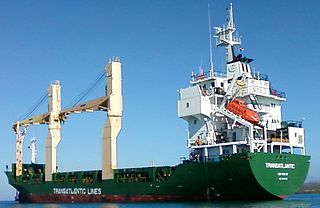
MV Maria Reina is a Panamanian container ship. The 100-metre (330 ft) long ship was built at Wuhu Shipyard in Wuhu, China in 1997 as Steamers Future. Originally owned by Singapore's Keppel Corporation, she has had three owners, been registered under three flags, and been renamed ten times.
Sealift Incorporated is an American shipping company based in Oyster Bay, New York. The privately held corporation was founded in 1975 by the four owners who remain the principal executives. Sealift Inc. is one of the largest ocean contractors for transporting U.S. food aid and participates in the Voluntary Intermodal Sealift Agreement. Between the start of fiscal 2000 and the first quarter of 2008, Sealift Inc. was awarded US$402,151,046 in contracts.

MV Maj. Bernard F. Fisher (T-AK-4396) is a U.S. Military Sealift Command vessel named for US Air Force Medal of Honor recipient Bernard F. Fisher. The vessel is a civilian-owned and operated container ship under contract to deliver pre-positioned supplies and equipment under the Military Sealift Command's Prepositioning Program. The Fisher is one of eight container ships that support Navy, Defense Logistics Agency, Air Force, Marine Corps and US Army operations as part of Maritime Prepositioning Ship Squadron Three.

USNS GySgt Fred W. Stockham (T-AK-3017) is a Shughart-class container & roll-on roll-off support vessel in the United States Navy's Military Sealift Command (MSC). The vessel is the second Navy ship named after Marine Gunnery Sergeant Fred W. Stockham (1881–1918), who was posthumously awarded the Medal of Honor during World War I.

MV Kalia is a small double-hulled oil tanker managed by Adminros Shipmanagement Company, Ltd. and registered under the flag of Cyprus. The 109-meter-long ship has a nominal crew of 13 and can carry 30,000 barrels (4,770 m3) of oil. While known as the MV Montauk, the ship was owned by the American company Sealift Incorporated, and sailed under long-term charter to the United States Military Sealift Command where it transported oil for the U.S. Department of Defense.
The Type C7 ship(Lancer Class) is a United States Maritime Administration (MARAD) designation for a cargo ship and the first US purpose-built container ship. The vessels were constructed in US shipyards and entered service starting in 1968. As US-built ships they were Jones Act qualified for shipments between US domestic ports. Under the Jones Act, domestic US maritime trade is restricted to US-built and flagged vessels of US owners and manned by predominantly US-citizen crews. The last active Lancer container-configured ship was scrapped in 2019. Lancers of the vehicle Roll-on/Roll-off (RO/RO) configuration remain held in the Ready Reserve Force, National Defense Reserve Fleet and the US Navy Military Sealift Command. All are steam powered.

The Maersk Peary is a tanker, operated by the shipping firm Maersk Line, that was designed for working in the polar regions.



















